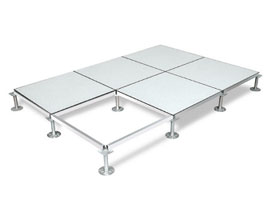The purpose of this article is to provide a basis of "Best Practices of RAISED FLOOR" for data center management and infrastructure. This can be applied to your data center. Insuring that the raised floor is structurally sound, well grounded and maintained in a proper manner contributes not only to the overall reliability of the data center; but, to safety as well.
Design
The following should be considered and implemented in the design of the data center raised floor.
- The raised floor grid should be grounded to the ground reference (meaning earth ground).
- Use "white space" to spread out the equipment and prevent hot spots
- A floor tile layout grid marked either on the walls or the tiles themselves will provide an easy reference to any equipment location. This grid layout can also be indicated on any columns
- Any sub-floor infrastructure (valves, electrical panels, etc.) should be noted with signage. The same applies to any infrastructure in the ceiling that cannot be seen
- Fiber cabling runs in the raised floor should be protected in either metal cable raceways or by some other protection method
- Servers should be elevated off of the floor so that air intakes do not become clogged with dust and dirt
- In areas where earthquakes are prevalent, earthquake restraints should be installed on all equipment, storage cabinets and shelving
- In earthquake prone areas, equipment should be installed on the Iso-Base product.
- All equipment racks should be equipped with a power distribution unit. The use of power strips to connect to electrical circuits is viewed as a safety hazard.
Operations
The following should be considered and implemented in the operations of the data center raised floor.
- A proactive maintenance program is critical to long-term effectiveness of any program designed for system availability.
- A data center audit should be conducted on a regular basis by an outside, impartial firm
- The raised floor and pedestals should be checked on a regular basis for leveling and fit. Warped, protruding or badly fitting tiles should be replaced.
- The sub-floor are should be cleaned with a vacuum on a regular basis in order to prevent debris from being blown into the equipment racks.
- Tiles that have galvanized, non-painted surfaces on the bottom of the tiles should be checked for zinc whiskers. The zinc in galvanized tiles will come off in 2-micron whiskers. These may be blown into the equipment racks.
- Unused data cables should be removed from the sub-floor. This is a NFPA code requirement.
- Marking tiles or using contrasting color tiles to indicate where equipment can be installed versus reserved space for infrastructure or white space alleviates layout confusion
- Use yellow hazard tape on the tiles to guide foot traffic away from critical or non workspace areas
- Raised flooring that has electroplated passivated sheet metal bottoms with wood cores is subject to zinc whiskers. These are approximately 2 microns thick, and can be blown into equipment. Inspect the bottoms of the tiles with a flashlight at an oblique angle. If the surface twinkles, zinc whiskers are present.
- At no time should wire spools with excess wire or cable be left under the floor. These contribute to poor air distribution
- Equipment should be unpacked outside the data center to reduce the amount of debris and dirt circulating in the space
- Storage of cardboard boxes in the data center should not be permitted. Doing so is a fire hazard and contributes to the amount of dust and fiber circulated into the equipment.
- No food or drink should be allowed in the data centers at any time.

















0 comments:
Post a Comment